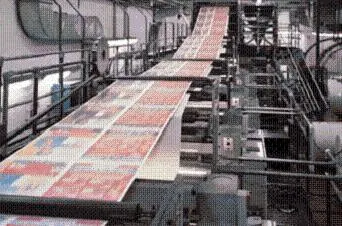PRINTING
Printing is a process of production of text and images, typically with ink on paper using a printing press. It is an essential part of publishing and transaction printing.Beginning of Writing :
Man was used signs and symbols to communicate his thoughts. This conversation has no permanent importance. Intellect tried to give a written form to these words. In first phase, pictures were developed to communicate one’s thoughts. The Chinese and Japanese modes of writing are thought to be the oldest ones.
After the invention of mode of writing, different things were used for writing, e.g., leather, barks of trees, wax sheets, shoulder bones of animals etc.
Formation of Books :
Researchers said that “Papyrus” tree was used for writing on it by Egyptians about 500 BC.
Man did not stop thinking and also started to write on leather. It was folded and bound. By this process, the first book of the world was come into being.
Invention of Paper :
“Kanso” was the province of China where a person, named ‘Cylon’ had invented the paper by mashing the old clothes and net, after drying the moisturizer of mashed material, it was made itself the soft but the little thick paper. Before the invention of paper, man used silk material for writing but after the invention of paper, the process of writing became easy for human beings.
Evolution of Printing :
Like invention of paper, printing was also started from China. Wood-block printing was used by the sixth century. A Chinese writer named Fenzhi first mentioned that the wood-blocks were used to print Buddhist scripture, during 627-649 AD. Printing is considered one of the four great inventions of ancient China.
Block Printing :
Block printing is done through following steps :
1. Production of the original document.
2. It is laid on a large, smooth wooden block and fixed into place.
3. Carve the original painted, drawn a written image into the block of wood.
4. The block can now be covered with ink and used in a press to create duplicates of the original. Blocks of wood, linoleum, rubber or even of potatoes are made for printing.
The Oldest Book :
The oldest surviving book was block printed book. It was published in 868 AD.
Movable Types :
The Chinese also perfected a system of movable type, first using clay and later blocks of woods for individual character. The Koreans were experimenting with movable metal type by the beginning of the 15th Century.
Block print was thought to be superior than movable type for a language such as Chinese which has a very broad character set, block prints were much cheaper. It was a draw-back of blocks that these were not durable.
Printing in Europe :
The next major invention occurred in Germany, where John Gutenberg is generally credited with developing a printing press that used movable metal type. Gutenberg published his famous Bible around 1453, and his new printing method quickly spread across Europe. Only 30 years after Gutenberg’s Bible appeared, there were printing presses in more than 110 towns in Western Europe alone. The total increase in the number of books available in Europe is impossible to calculate, but is probably safe to say that by 1500, there were hundred of times more books available than in 1450. As books proliferated, their cost went down. Although still expensive, books were no longer the exclusive possession of the very rich. The printed books could now be afforded by those who were simply relatively prosperous.
The consequences of the printing revolution are so far-reaching and extensive that it is impossible to discuss all of them. Most scholars seem to agree, however, on the most significant results.
Some important events were taken place as follows :
1453 Bible was published by John Gutenberg
1457 Coloured printing was started
1464 Printing in Rome was started
1468 Printing press was formed in Switzerland
1470 France was entered in the field of printing by two German natives
1471 Printing was introduced in Holland
Beginning of Printing in England :
In England, printing was started in the last of other European countries which was introduced by William Kankston who had learn printing from Germany. In 1476, he established a printing press in England from where he published translations of many books. His first publication was religious document published on 13th December, 1476. He published more than hundred books from his printing press.
In England, the art of printing was entered in a different way as compared to other European countries. Because in England, the art of printing was introduced by an English man while in the other countries of Europe, printing was started through Germans.
Publishing History of the World :
The clay tablets of the ancient Middle East and the papyrus scrolls used by the Egyptians were the earliest ancestors of books. During the Middle Ages, manuscripts were inscribed by hand and many were lavishly decorated-some even burnished with gold. Many books were valued as works of art.
Until approximately the twelfth century, most books in Europe Were produced by monks in monasteries. These books were mainly various translations of the Bible and other religious works such as the lives of the saints. All of this changed in about 1250 when professional scribes replaced monks as book prepares. Books were no longer the exclusive property of religious organizations. Private individuals could hire a scribe and acquire a book. Consequently, new types of books came into being, illustrated epic poems, narratives of battles and adventures, romantic stories and textbooks.
15th Century :
The next breakthrough occurred in the 15th Century; the development of movable type worked with a printing press. Early types of printing presses had existed in China long before the 15th Century, but these presses used a technique called xylography, in which each image, word, or group of words was carved on a separate wooden block.
The invention of movable metal type suitable for printing is generally credited to Johan Gutenberg. Trained'as a metal worker, Gutenberg developed a way to cast metal type and to encase it in a wooden mold that could then be attached to a printing press.
In about 1455, Gutenberg printed his first book Bible.
The Penny-Press Era :
The change in printing technology and the growth of literacy mentioned above also helped the publishing industry. Many of the publishing companies still active today can trace their roots to the early 18003. The number of public libraries tripled between 1825 and 1850. Specialized books also appeared.









0 Comments